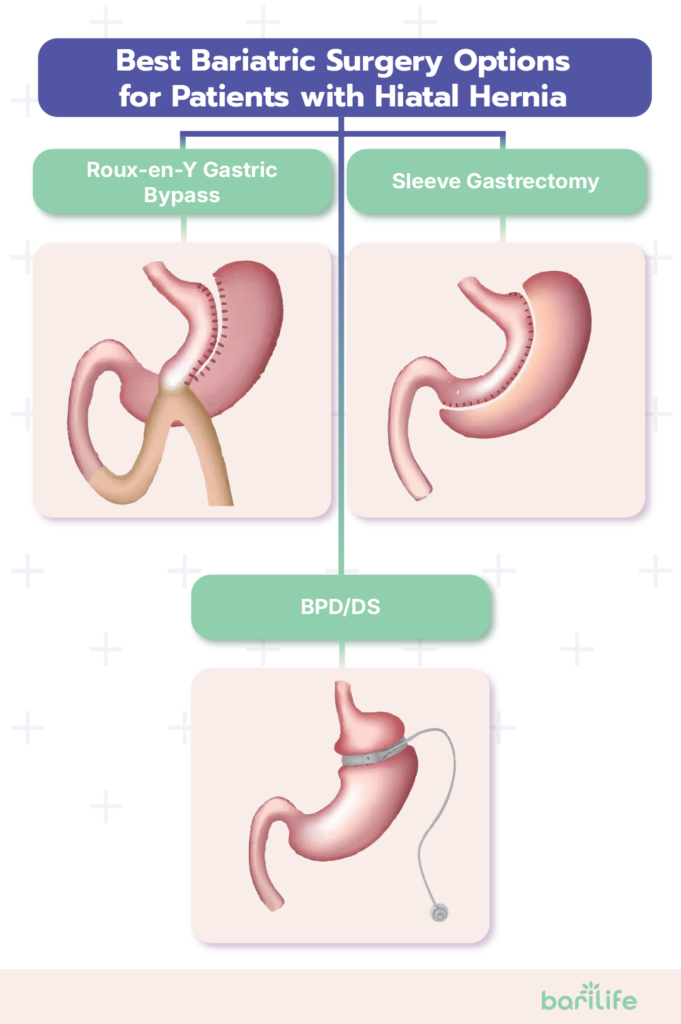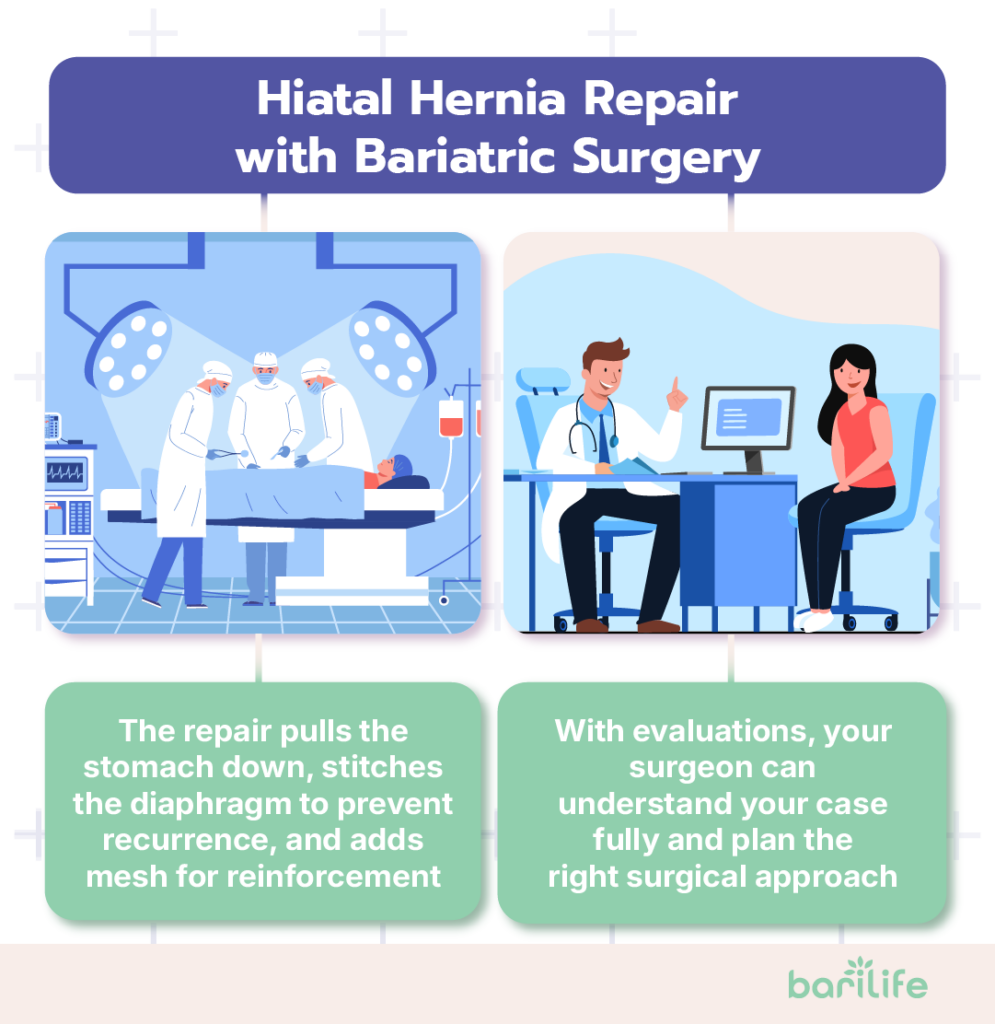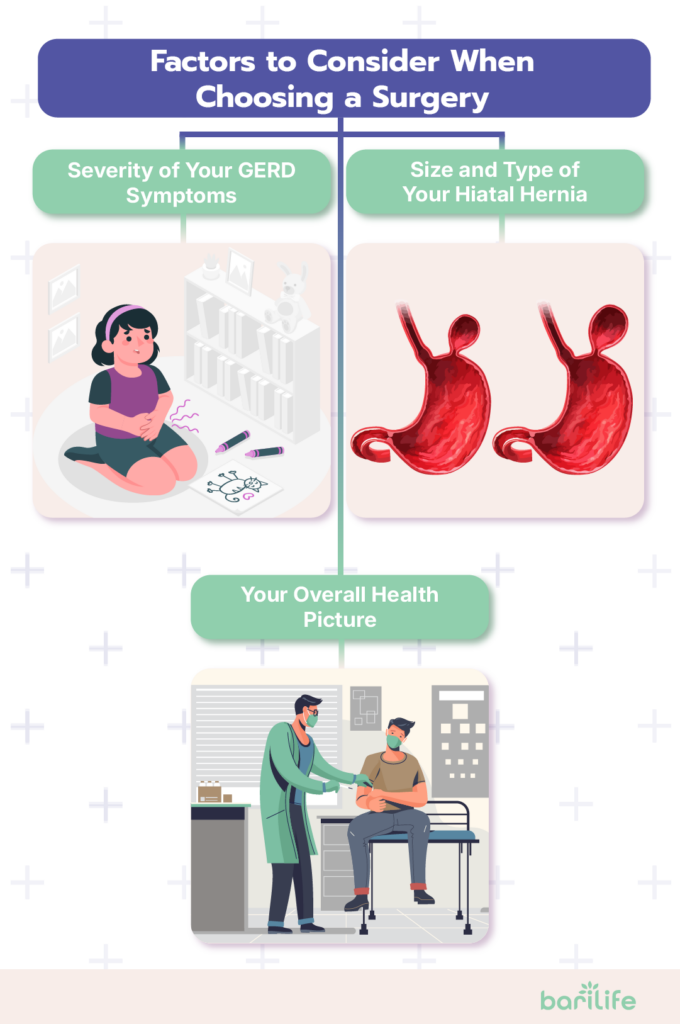Key Takeaways:
- Many bariatric surgery candidates have some degree of hiatal hernia, as excess abdominal fat increases pressure on the stomach and pushes it upward.
- Roux-en-Y gastric bypass is often considered the gold standard for patients with hiatal hernias.
- For optimal results, hiatal hernias should be repaired during the same operation as bariatric surgery rather than waiting for a separate procedure.
Are you considering bariatric surgery, but you’re worried about your hiatal hernia diagnosis? You’re not alone. The frustrating combination of obesity and hiatal hernia impacts thousands of people.
The good news is that having a hiatal hernia doesn’t mean you can’t have bariatric surgery. In fact, many bariatric surgeons routinely address both issues during the same operation. Let’s dive into what you need to know about finding the best bariatric surgery for hiatal hernia.
Table of Contents
Understanding Hiatal Hernia in Bariatric Patients

First, let’s clarify what a hiatal hernia is and why it matters for bariatric patients.
What Is a Hiatal Hernia?
A hiatal hernia happens when part of your stomach pushes upward through your diaphragm (the muscle that separates your chest from your abdomen) into your chest cavity. The opening through which the stomach protrudes is called the hiatus, which is why it is referred to as a “hiatal” hernia.
Your diaphragm has a small opening for your esophagus (food pipe) to connect to your stomach. However, with a hiatal hernia, this opening becomes larger, allowing part of the stomach to bulge through where it doesn’t belong.
Why Are They So Common in People Considering Bariatric Surgery?
If you’re dealing with obesity, you’re far from alone in also having a hiatal hernia. Research shows that patients who have a body mass index (BMI) of over 35 are at a higher risk of developing a hiatal hernia. 40% of bariatric surgery candidates are found to have some degree of hiatal hernia when they’re evaluated before surgery. Many also experience GERD, further strengthening the case for bariatric surgery for GERD.
While the exact reason for this is not entirely known, it may be due to increased abdominal pressure resulting from excess weight.
Symptoms You Might Experience
Many people with hiatal hernias experience uncomfortable symptoms, particularly related to acid reflux or gastroesophageal reflux disease (GERD). You might experience:
- Heartburn, especially after meals or when lying down
- Chest pain that might be confused with heart problems
- Difficulty swallowing
- Feeling uncomfortably full after eating small amounts
- Chronic cough
- Hoarse voice
These symptoms occur because the hiatal hernia allows acid in your stomach to flow back up into your esophagus, causing irritation and discomfort.
The Silent Hernia
Interestingly, not everyone with a hiatal hernia experiences symptoms. You might have what doctors call an “asymptomatic” hiatal hernia. These silent hernias are often discovered incidentally during testing for other conditions or during the pre-surgical evaluation for bariatric surgery.

Even if your hernia isn’t causing obvious symptoms now, your surgical team will likely recommend repairing it during your bariatric procedure.
Best Bariatric Surgery Options for Patients with Hiatal Hernia
When it comes to the best bariatric surgery for hiatal hernia, there’s no one-size-fits-all answer. However, certain procedures tend to be more effective than others for patients with this condition.
Roux-en-Y Gastric Bypass
Many surgeons consider Roux-en-Y gastric bypass (RYGB) to be the gold standard bariatric procedure for patients with hiatal hernias, especially those with significant reflux symptoms.
The procedure creates a small stomach pouch that reduces acid production. Food bypasses part of the small intestine, which lessens the chance of acid reflux. The new anatomy makes it physically challenging for the contents in your stomach to flow back into the esophagus.
Studies show it resolves GERD symptoms in about 80-85% of patients. RYGB also shows a lower rate of hernia recurrence compared to other bariatric procedures.
Sleeve Gastrectomy
Sleeve gastrectomy is a common type of bariatric procedure. However, if you have a hiatal hernia, you may want to avoid this procedure.
The sleeve procedure can potentially worsen GERD symptoms in some patients if a hernia is not repaired. When combined with proper hiatal hernia repair, many patients do experience improvement. The procedure is technically simpler than bypass and has other advantages, like no rerouting of the intestines.
Other Procedures to Consider
While RYGB and sleeve gastrectomy are the most common options, other procedures might be considered depending on your specific situation:
Adjustable Gastric Banding:
This procedure has become less popular in recent years due to higher long-term complication rates. It’s generally not recommended for patients with hiatal hernias, as the band can potentially exacerbate hernia symptoms.
Duodenal Switch
This more complex procedure can be effective for weight loss but is typically reserved for patients with higher BMIs. For those with hiatal hernias, it may be combined with hernia repair, though it’s less commonly performed than RYGB or sleeve gastrectomy.

Combining Procedures for Optimal Results
Whatever bariatric procedure you and your surgeon decide on, current best practice strongly favors addressing both the weight issue and the hernia during the same operation. This combined approach optimizes surgical outcomes, prevents complications, and eliminates the need for a second surgery.
Hiatal Hernia Repair with Bariatric Surgery
Let’s examine the procedure in more detail, specifically how hiatal hernia repair is typically performed in conjunction with bariatric surgery, and why this combined approach is effective.
The Benefits of Simultaneous Repair
Repairing your hiatal hernia during bariatric surgery offers several advantages. You’ll only need to go through surgery and recovery once. Addressing the hernia removes a potential obstacle to comfortable eating after surgery, which can improve weight loss outcomes.
Combined procedures show better long-term relief from reflux symptoms. Additionally, leaving a hernia unrepaired could lead to issues like stomach slippage or obstruction.
Research supports this approach, with studies showing that patients who have combined procedures typically experience better symptom relief and fewer complications than those who have bariatric surgery alone.
How the Repair Is Done
Most hiatal hernia repairs during bariatric surgery are done using the same laparoscopic (minimally invasive) approach as the bariatric procedure itself. Here’s what typically happens:
- The portion of the stomach that has pushed through the diaphragm is pulled back down into the abdomen
- The diaphragm opening is made smaller with stitches to prevent the stomach from slipping back up
- In some cases, a mesh material might be used to reinforce the repair
- The bariatric procedure (bypass, sleeve, etc.) is then performed
The Importance of Preoperative Assessment
Before your surgery, your medical team will need to thoroughly evaluate your hiatal hernia. This typically involves:
- Upper endoscopy: A thin, flexible tube camera is passed down your throat to directly visualize the hernia and check for related issues like esophagitis

- Barium swallow study: This special X-ray helps show the size and location of the hernia
- Esophageal manometry: This test checks how well the muscles in your esophagus work, which can be important for surgical planning
This comprehensive evaluation enables your surgeon to understand exactly what they are dealing with and plan the most appropriate surgical approach for your specific situation.
Factors to Consider When Choosing a Surgery
Here are some factors that will impact the decision about the best bariatric surgery for hiatal hernia in your case.
Severity of Your GERD Symptoms
If you have significant acid reflux symptoms that impact your quality of life, this will weigh heavily in the decision-making process:
- Mild or no GERD symptoms: You might have more flexibility in the choice of procedure, although repair of any identified hernia would still be recommended
- Moderate GERD: Sleeve gastrectomy with hernia repair might be adequate, though RYGB would also be appropriate
- Severe GERD: RYGB often becomes the procedure of choice due to its superior results for reflux relief
Size and Type of Your Hiatal Hernia
The characteristics of your specific hernia also matter:
- Small sliding hernias are the most common and generally straightforward to repair with any bariatric procedure
- Larger hernias might influence your surgeon to lean toward RYGB, as these have a lower recurrence rate with this procedure
- Paraesophageal hernias are less common but more complex and might also make your surgeon favor RYGB
Your Overall Health Picture
Your complete health status plays a significant role in surgical decision-making:
- Diabetes: RYGB typically shows superior results for diabetes improvement
- Heart disease: The simplicity of sleeve gastrectomy might be more favorable if you have cardiac issues
- Age: Younger patients might benefit from the more durable weight loss of RYGB
- Previous abdominal surgeries: These might influence the technical aspects of different procedures

The ultimate goal is to choose the procedure that offers the ideal balance of benefits and risks for your unique situation.
Recovery and Post-Surgery Management
Once you’ve had your combined bariatric surgery and hiatal hernia repair, what can you expect during recovery?
Your Diet After Surgery
Your post-surgery diet will follow a careful progression designed to allow both your bariatric procedure and hernia repair to heal properly. You’ll start with a diet limited to clear liquids, then progress to pureed, then soft foods, and finally to normal consistency.
Watching for Potential Complications
After combined surgery, you’ll need to stay alert for possible signs of complications related to either the bariatric procedure or the hernia repair:
- Severe abdominal pain: Could indicate a leak, obstruction, or other serious issue
- Persistent nausea or vomiting: Might suggest an obstruction or narrowing
- Return of reflux symptoms: Could indicate hernia recurrence
- Difficulty swallowing: Might point to swelling or stricture
- Fever or increased heart rate: Potential signs of infection
Most patients recover without major complications; however, recognizing these warning signs ensures that you can seek help promptly if needed.
Lifestyle Considerations for Long-Term Success
For lasting success after your surgery, some key lifestyle adjustments will be important:
Eating Habits
- Eat slowly and chew thoroughly
- Stop eating when you feel full
- Avoid carbonated beverages that can cause bloating
- Limit sugary and high-fat foods
Physical Activity
- Begin with gentle walking soon after surgery
- Gradually increase activity as approved by your surgical team
- Build up to regular exercise that you enjoy
- Avoid heavy lifting (more than 15-20 pounds) for at least 6 weeks
Lifestyle Factors
- Elevate the head of your bed if you have reflux symptoms
- Avoid lying down right after eating
- Quit smoking since it can increase the recurrence of hiatal hernia.
- Wear loose-fitting clothing that doesn’t constrict your abdomen
These adjustments not only support your weight loss but also help prevent the recurrence of your hiatal hernia.

The Importance of Follow-Up Care
Regular follow-up appointments are crucial after combined bariatric surgery and hiatal hernia repair. You will typically have an initial post-operative check-up in the first week, followed by several more assessments of healing and diet progression.
These visits enable your medical team to monitor your progress, adjust your health plan as necessary, and identify potential issues early.
Conclusion
Choosing the best bariatric surgery for a hiatal hernia comes down to a thoughtful discussion between you and your surgical team. Their expertise matters tremendously. You want a bariatric surgeon with specific experience in hiatal hernia repair and various bariatric procedures.
With the correct procedure and proper follow-up care, most patients experience significant improvement in both their weight and hernia-related symptoms.
How Bari Life Can Help
Nutritional support is crucial during recovery from combined bariatric surgery and hiatal hernia repair. Bari Life offers a comprehensive range of bariatric vitamins, including bariatric multivitamins and bariatric vitamins chewable, which are gentle on your healing digestive system. These specially formulated supplements provide the essential nutrients needed for proper healing and long-term success.
In addition to liquid bariatric vitamin options for those who have difficulty swallowing pills, Bari Life also offers bariatric multivitamin with iron to address common post-surgery deficiencies. For patients concerned about thinning hair, our bariatric vitamins for hair loss are designed to support healthy hair regrowth during your recovery journey.
Protein is another critical component of post-operative nutrition. Our bariatric protein shakes and bariatric protein bars are crafted to be easy on the stomach while delivering high-quality protein to help preserve lean muscle mass and promote healing.
To help you stay on track with your nutrition, Bari Life also provides a selection of bariatric snacks that are both satisfying and appropriate for your post-surgery dietary needs. Additionally, our bariatric calcium chews offer a convenient way to maintain bone health, and our bariatric probiotic supports optimal gut health and digestion during this crucial time.
Visit Bari Life today to explore our complete line of bariatric-specific nutritional products designed to support your recovery and help you maintain the improvements in both your weight and hernia-related symptoms following your procedure.
If you want to learn more, why not check out these articles below:
- PCOS and Bariatric Surgery
- Bariatric Surgery and Diabetes
- Does Bariatric Surgery Cure Diabetes
- Bariatric Surgery For Hypertension
- Malabsorptive Bariatric Surgery
- Bariatric Surgery and Gallbladder



What are your tips and tricks to post-bariatric success?